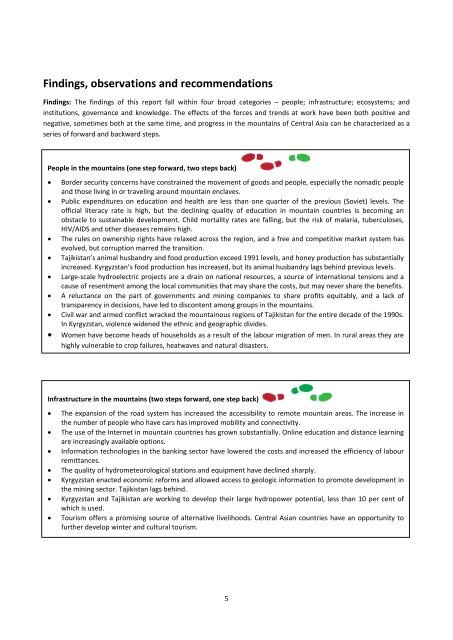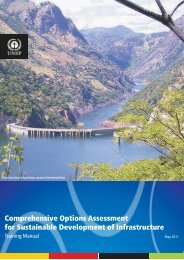Download - Rio+20
Download - Rio+20
Download - Rio+20
Create successful ePaper yourself
Turn your PDF publications into a flip-book with our unique Google optimized e-Paper software.
Findings, observations and recommendations<br />
Findings: The findings of this report fall within four broad categories – people; infrastructure; ecosystems; and<br />
institutions, governance and knowledge. The effects of the forces and trends at work have been both positive and<br />
negative, sometimes both at the same time, and progress in the mountains of Central Asia can be characterized as a<br />
series of forward and backward steps.<br />
People in the mountains (one step forward, two steps back)<br />
• Border security concerns have constrained the movement of goods and people, especially the nomadic people<br />
and those living in or traveling around mountain enclaves.<br />
• Public expenditures on education and health are less than one quarter of the previous (Soviet) levels. The<br />
official literacy rate is high, but the declining quality of education in mountain countries is becoming an<br />
obstacle to sustainable development. Child mortality rates are falling, but the risk of malaria, tuberculoses,<br />
HIV/AIDS and other diseases remains high.<br />
• The rules on ownership rights have relaxed across the region, and a free and competitive market system has<br />
evolved, but corruption marred the transition.<br />
• Tajikistan’s animal husbandry and food production exceed 1991 levels, and honey production has substantially<br />
increased. Kyrgyzstan’s food production has increased, but its animal husbandry lags behind previous levels.<br />
• Large-scale hydroelectric projects are a drain on national resources, a source of international tensions and a<br />
cause of resentment among the local communities that may share the costs, but may never share the benefits.<br />
• A reluctance on the part of governments and mining companies to share profits equitably, and a lack of<br />
transparency in decisions, have led to discontent among groups in the mountains.<br />
• Civil war and armed conflict wracked the mountainous regions of Tajikistan for the entire decade of the 1990s.<br />
In Kyrgyzstan, violence widened the ethnic and geographic divides.<br />
• Women have become heads of households as a result of the labour migration of men. In rural areas they are<br />
highly vulnerable to crop failures, heatwaves and natural disasters.<br />
Infrastructure in the mountains (two steps forward, one step back)<br />
• The expansion of the road system has increased the accessibility to remote mountain areas. The increase in<br />
the number of people who have cars has improved mobility and connectivity.<br />
• The use of the Internet in mountain countries has grown substantially. Online education and distance learning<br />
are increasingly available options.<br />
• Information technologies in the banking sector have lowered the costs and increased the efficiency of labour<br />
remittances.<br />
• The quality of hydrometeorological stations and equipment have declined sharply.<br />
• Kyrgyzstan enacted economic reforms and allowed access to geologic information to promote development in<br />
the mining sector. Tajikistan lags behind.<br />
• Kyrgyzstan and Tajikistan are working to develop their large hydropower potential, less than 10 per cent of<br />
which is used.<br />
• Tourism offers a promising source of alternative livelihoods. Central Asian countries have an opportunity to<br />
further develop winter and cultural tourism.<br />
5
















